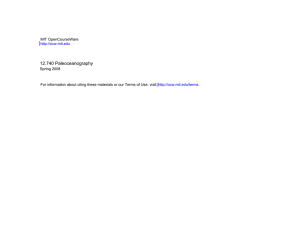Document 12533917
advertisement
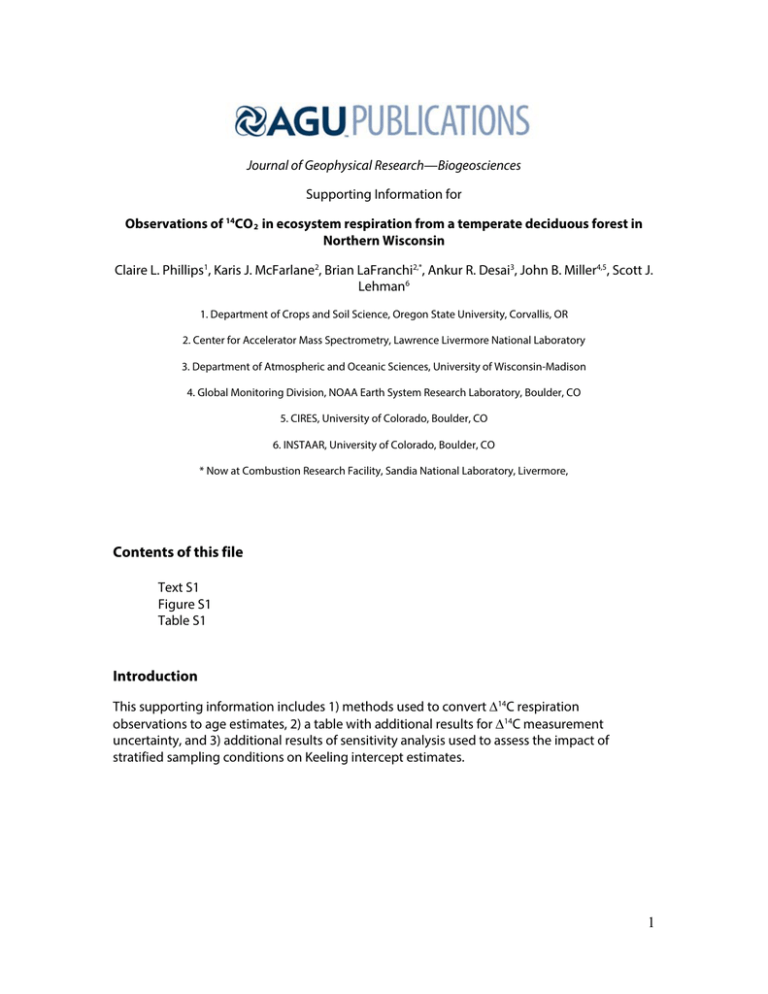
Journal of Geophysical Research—Biogeosciences Supporting Information for Observations of 14CO 2 in ecosystem respiration from a temperate deciduous forest in Northern Wisconsin Claire L. Phillips1, Karis J. McFarlane2, Brian LaFranchi2,*, Ankur R. Desai3, John B. Miller4,5, Scott J. Lehman6 1. Department of Crops and Soil Science, Oregon State University, Corvallis, OR 2. Center for Accelerator Mass Spectrometry, Lawrence Livermore National Laboratory 3. Department of Atmospheric and Oceanic Sciences, University of Wisconsin-Madison 4. Global Monitoring Division, NOAA Earth System Research Laboratory, Boulder, CO 5. CIRES, University of Colorado, Boulder, CO 6. INSTAAR, University of Colorado, Boulder, CO * Now at Combustion Research Facility, Sandia National Laboratory, Livermore, Contents of this file Text S1 Figure S1 Table S1 Introduction This supporting information includes 1) methods used to convert ∆14C respiration observations to age estimates, 2) a table with additional results for ∆14C measurement uncertainty, and 3) additional results of sensitivity analysis used to assess the impact of stratified sampling conditions on Keeling intercept estimates. 1 Text S1. Methods for converting ∆14C to age estimates. Calibrated age ranges were determined by matching observed 14C values to the monthly Northern Hemisphere Zone 1 atmospheric 14C calibration record for 1950–2009 AD [Hua et al., 2013] using Calibomb (http://calib.qub.ac.uk/CALIBomb/). This program gives a distribution of possible solutions based on variation in the atmospheric record over time and errors associated with the calibration dataset and measured/estimated 14C value (Reimer et al., 2004). Decimal years were rounded to the nearest growing season (defined here as May through September). For respiration values with two-sigma age ranges that overlapped the end of the Northern Hemisphere Zone 1 record in 2009, the minimum age was determined by matching the values to weekly growing season measurements from Niwot Ridge through 2011 AD (Lehman et al., 2013). For the overlapping period, 2003-2009 these two atmospheric 14C datasets are consistent with one another within one standard deviation. Radiocarbon values below the 2012 AD atmospheric 14C value extrapolated from Lehman et al., 2013 (∆14C = 3‰), the minimum age was set to the end of the growing season in 2012, the year of sampling. All measured or estimated 14C values yielded an alternative calibrated age, typically 19551957 AD, corresponding to the upswing of the atmospheric bomb 14CO 2 curve. However, we consider this set of age solutions unlikely considering our approach to measuring the 14 C of R h and R s (R s, which includes root respiration, should be more contemporary than R h , which excludes root respiration) and that it is unlikely that R eco , R s , and R h would consistently fall within such a narrow range in age (57-59 years old). Lehman, S. J., Miller, J. B., Wolak, C., Southon, J., Tans, P. P., Montzka, S. A., Sweeney, C., Andrews, A. E., LaFranchi, B. W., Guilderson, T. P. and Turnbull, J. C.: Allocation of terrestrial carbon sources using 14CO 2 : Methods, Meaurement, and Modeling, Radiocarbon, 55(2-3), 1484–1495, 2013. Reimer, P. J., Baillie, M., Bard, E., Bayliss, A., Beck, W., Bertrand, C. and Blackwell, P.: IntCal04 terrestrial radiocarbon age calibration, 0-26 cal kyr BP, 2004. 2 Figure S1. Theoretical ∆14CO 2 values and Keeling plots for CO 2 profiles for different assumed mixtures of foliar and soil respiration during nighttime sampling windows. ∆14CO 2 values were calculated by assuming CO 2 in excess of the background atmosphere was derived either from: 1) R s only, 2) a stratified mixture of R s and foliar respiration (R f ), with the contribution from R s increasing linearly with proximity to ground from 0% at 21 m to100% at the soil surface, or 3) an even mixture of R s and R f , with R s contributing 75% of excess CO 2 at all canopy heights. We assumed a background atmosphere of CO 2 = 380 ppm and ∆14CO 2 = 30‰; ∆14C-R f = 30‰; and ∆14C-R s = 54.6‰ in June and 45.6‰ in August, as measured from soil chambers. Panels a-f show analysis for June 30-July 1, and g-l show analysis for sampling window Aug 25-26, 2011. Panels a-c and g-i show computed ∆14CO 2 profiles, panels d-f and j-l show ∆14C versus 1/CO 2 (Keeling plots). 3 1 Table S1. Performance of high precision AMS methods based on two surveillance standards (La Jolla Atmospheric Radiocarbon Standard, LARS). Both tanks contain air sampled from Scripps pier in 2010. LARS2 has been spiked with additional fossil CO 2 . The standard deviation of N unique samples is σ, and mean standard deviation of counting statistics from N samples is AMS uncertainty. The ∆14C of these cylinders has not been independently validated by other AMS facilities. Samples taken directly from control cylinders or via PFPs yielded measurement values that are the same within uncertainties for repeat measurements. mean AMS Extraction uncertainty Standard Method N (‰) σ (‰) ∆14C (‰) LARS1 from cylinder 11 3.65 1.93 31.1 LARS2 from cylinder 5 3.27 1.55 -51.7 LARS1 from PFP 5 3.24 1.84 32.9 LARS2 from PFP 2 1.99 -51.6 overall 23 3.4 1.8 1
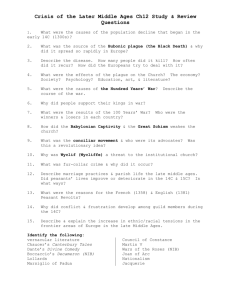
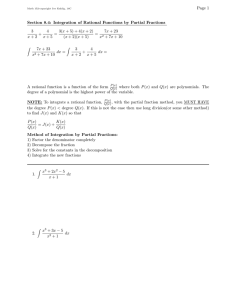
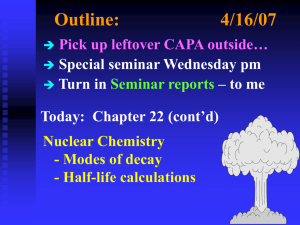
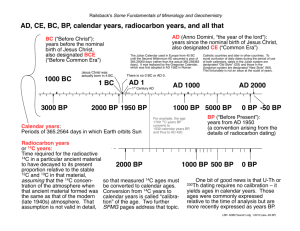
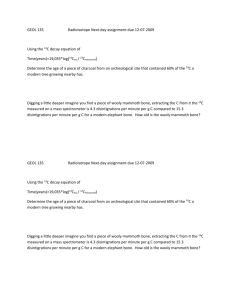
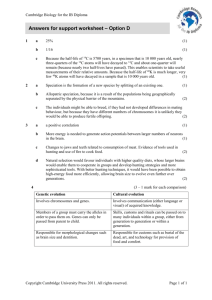
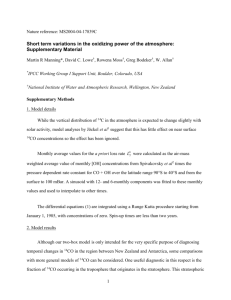
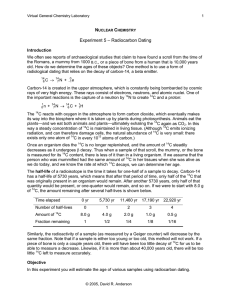
![AMSRadiocarbon Dating of Bone Samples from the Xinzhai Site in China[J]. Radiocarbon, 2005, 47(1).](http://s3.studylib.net/store/data/025533976_1-d8b12d8810d8ed65b486b585926d0541-300x300.png)

